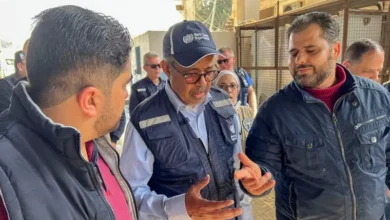Ukraine: What are cluster munitions? Is using them a war crime?

The United States has decided to send cluster munitions to Ukraine to help its military push back Russian forces entrenched along the front lines.
The Biden administration is expected to announce on Friday that it will send thousands of them as part of a new military aid package worth $800m, according to people familiar with the decision who were not authorised to discuss it publicly before the official announcement and spoke on condition of anonymity.The move will likely trigger outrage from some allies and humanitarian groups that have long opposed the use of cluster bombs.
Proponents argue that Russia has already been using the controversial weapon in Ukraine and that the munitions the US will provide have a reduced dud rate, meaning there will be far fewer unexploded rounds that can result in unintended civilian deaths.
Here is a look at what cluster munitions are, where they have been used and why the US plans to provide them to Ukraine now.
What is a cluster munition?
A cluster munition is a bomb that opens in the air and releases smaller “bomblets” across a wide area. The bomblets are designed to take out tanks and equipment, as well as troops, hitting multiple targets at the same time.The munitions are launched by the same artillery weapons that the US and allies have already provided to Ukraine for the war – such as howitzers – and the type of cluster munition that the US is planning to send is based on a common 155mm shell that is already widely in use across the battlefield.
In previous conflicts, cluster munitions have had a high dud rate, which meant that thousands of the smaller unexploded bomblets remained behind and killed and maimed people decades later. The US last used its cluster munitions in Iraq in 2003, and decided not to continue using them as the conflict shifted to more urban environments with denser civilian populations.
On Thursday, Brig Gen Pat Ryder said the Department of Defense has “multiple variants” of the munitions and “the ones that we are considering providing would not include older variants with [dud] rates that are higher than 2.35 percent”.
Why provide them now?
For more than a year, the US has dipped into its own stocks of traditional 155 howitzer munitions and sent more than two million rounds to Ukraine. Allies across the globe have provided hundreds of thousands more.A 155mm round can strike targets 24-32 kilometres (15-20 miles) away, making them a munition of choice for Ukrainian ground troops trying to hit enemy targets from a distance. Ukrainian forces are burning through thousands of rounds a day battling the Russians.Yehor Cherniev, a member of Ukraine’s parliament, told reporters at a German Marshall Fund event in the US earlier this year that Kyiv would likely need to fire 7,000 to 9,000 of the rounds daily in intensified counteroffensive fighting. Providing that kind of volume of munitions puts substantial pressure on US and allied stocks.
The cluster bomb is an attractive option because it would help Ukraine destroy more targets with fewer rounds, and since the US has not used them in conflict since 2003, it has large amounts of them in storage it can access quickly, said Ryan Brobst, a research analyst for the Foundation for Defense of Democracies.
A March 2023 letter from top House and Senate Republicans to the Biden administration said the US may have as many as three million cluster munitions available for use, and urged the White House to send the munitions to alleviate pressure on US war supplies.
“Cluster munitions are more effective than unitary artillery shells because they inflict damage over a wider area,” Brobst said. “This is important for Ukraine as they try to clear heavily fortified Russian positions.”
Tapping into the US stores of cluster munitions could address Ukraine’s shell shortage and alleviate pressure on the 155mm stockpiles in the US and elsewhere, Brobst said.Is using them a war crime?
The use of cluster bombs itself does not violate international law, but using them against civilians can be a violation. As in any strike, determining a war crime requires looking at whether the target was legitimate and if precautions were taken to avoid civilian casualties.
“The part of international law where this starts playing [a role], though, is indiscriminate attacks targeting civilians,” Human Rights Watch’s associate arms director Mark Hiznay told The Associated Press news agency. “So that’s not necessarily related to the weapons, but the way the weapons are used.”
A convention banning the use of cluster bombs has been joined by more than 120 countries, which agreed not to use, produce, transfer or stockpile the weapons and to clear them after they have been used. The US, Russia and Ukraine have not signed the agreement.
Where have they been used?
The bombs have been deployed in many recent conflicts, including where US forces were involved.
The US initially considered cluster bombs an integral part of its arsenal during the invasion of Afghanistan that began in 2001, according to HRW. The group estimated that the US-led coalition dropped more than 1,500 cluster bombs in Afghanistan during the first three years of the conflict.The Department of Defense had been due by 2019 to stop the use of any cluster munitions with a rate of unexploded ordnance greater than 1 percent. But the Trump administration rolled back that policy, allowing commanders to approve the use of such munitions.
Syrian government troops often used cluster munitions – supplied by Russia – against opposition strongholds during the country’s civil war, frequently hitting civilian targets and infrastructure. And Israel used them in civilian areas in south Lebanon, including during the 1982 invasion.
HRW and the United Nations accused Israel of firing as many as four million cluster munitions into Lebanon during its monthlong war with Hezbollah in 2006. That left unexploded ordnance that threatens Lebanese civilians to this day.
The Saudi-led coalition in Yemen has been criticised for its use of cluster bombs in the war with the Iran-backed Houthi rebels that has ravaged the southern Arabian country.
In 2017, Yemen was the second deadliest country for cluster munitions after Syria, according to the UN. Children have been killed or maimed long after the munitions originally fell, making it difficult to know the true toll.










